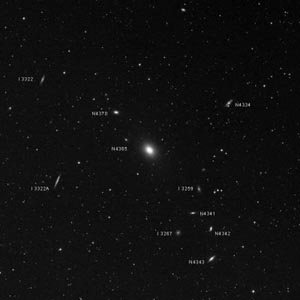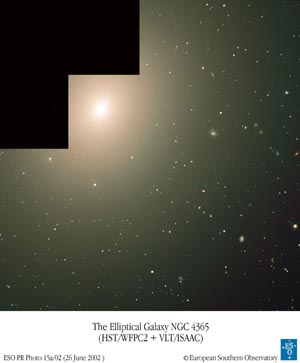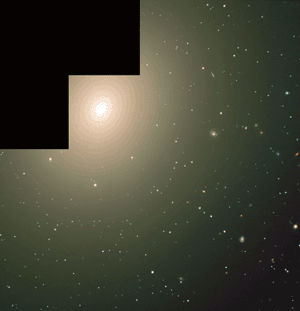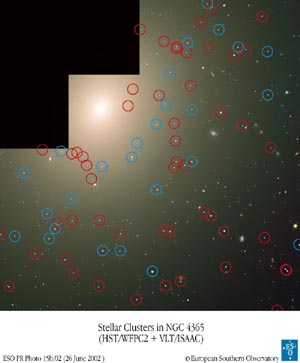Combined data from the NASA/ESA Hubble Space Telescope (HST) and the ESO Very Large Telescope (VLT) has led to a surprise astronomical find by European and American observers. They have spotted a large number of young stellar clusters, a mere few billion years old, within an old elliptical galaxy (NGC 4365). NGC 4365 is thought to be about 12 billion years old. This, say the astronomers, is the first time, several distinct periods of star formation have been seen in a galaxy as old as this one.
Modern astronomy is trying to understand how galaxies evolve. One question that is always on the agenda is to find out when most of the stars in the universe formed. Did this occur early in the life of the universe, just a few billion years after the Big Bang, or were many of the stars we now see formed much more recently?

The giant elliptical galaxy NGC 4365 (centre)
Astronomers have considered elliptical galaxies like NGC 4365 as being little more than early starters that gave up star formation after an initial burst of activity. But, the new studies reveals that elliptical galaxies are something of a cosmic dark horse.
However, spectacular collisions between galaxies are known to take place frequently, triggering the formation of thousands or even millions of stars. But, on the whole, most stars we observe sit tight in large elliptical galaxies for a very, very long time. Indeed, they are among the oldest objects in the Universe.

A colour composite of the elliptical galaxy NGC 4365. Many of the objects seen are stellar clusters in this galaxy
Markus Kissler-Patig of ESO headquarters in Garching, Germany, and colleagues there and at the University of Munich and in the USA have studied the stellar cocktail of the elliptical galaxy NGC 4365, which one of a cluster of galaxies in the constellation Virgo and saw massive stellar clusters in and around several nearby galaxies. These globular clusters are found in large numbers around most galaxies and receive an imprint for every episode of star formation they undergo. So, astronomers can read the age of the globular clusters in a galaxy and identify past star birth epochs.

The distribution of three populations of stellar clusters (a) old and metal-poor; (b) old and metal-rich; (c) young and metal-rich
Visible light images from several galaxies observed by Hubble’s Wide Field and Planetary Camera were combined with infrared images from the ESO Paranal Observatory in Chile. By looking at the colours of the globular clusters in NGC 4365, the astronomers discovered to their great surprise that many of these clusters are only a few billion years old, i.e. much younger than the age of most other stars in that galaxy. They espied an old population of clusters of metal-poor stars, clusters of old, but metal-rich stars and now, for the first time, a third population of clusters with young and metal-rich stars.

The distribution of old (red circles) and young (blue circles) stellar clusters in NGC 4365
We needed the combination of the Hubble and the VLT with the latest space- and ground-based astronomical technology to break this new ground, says group leader Kissler-Patig. Once we had found those young clusters, we then went on to observe them using spectroscopy with another of the world’s giant telescopes, the 10 metre Keck on Hawaii – and this fully confirmed our results.
This is a surprising discovery since the stars in giant elliptical galaxies were until now believed to have formed exclusively early on in the history of the Universe. But, some old galaxies may have been hiding their true nature and have experienced much more recent periods of major star formation.
The results will be published in more detail in Astronomy & Astrophysics.
Further reading
Suggested searches
Star formation
Galaxy formation
Stellar clusters
Hubble Space Telescope
Very Large Telescope